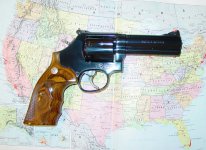I will just address your math. You are off by a factor of ten in both cases. Its 0.10 sq in for the .357 bullet, and 0.16 for the .452 bullet. Its pi r squared. Some folks say that pies are round, but we are talking math here!

. You need to divide the diameter by 2, and square it. Then, times 3.14. But, the 45 still has 60% more cross sectional area.
As far as the tissue damage goes, that depends on the bullet profile. When Jim Cirillo, as recounted in his book "Guns, Bullets and Gunfights", talked to Medical Examiners after a shooting, he was told that, with round nose bullets, they could not tell the difference in wound channels between a .32 cal and a .45 cal bullet. This is because the nose of the bullet makes a small hole, and the tissue stretches around the rest of the bullet, and then snaps back. Hollow points with the cavity plugged have been reported to act the same way. That is why Officer Cirillo preferred the wad cutter profile. He even loaded one in the chamber of his partners .45 auto, something he says saved his owned life when his partner shot a perp. during a stake out. I guess I have addressed more than just the math. As far as bullet diameter goes, you do get a slightly greater chance of hitting something vital with a larger bullet. But, it depends on the increase in radius, which, of course, is half the diameter. For a .357 and .452 diameter, the difference in radius is .048 inch.
My own thinking is that the only reason that an accurate shot wouldn't be effective would be if it didn't penetrate deep enough. These are the necessities. Everything else is nice.
Rick

